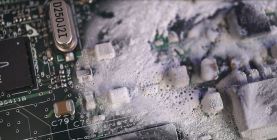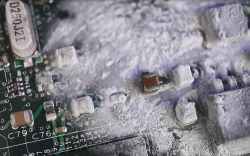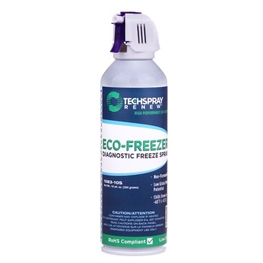Let’s say you are repairing a circuit board, and there’s a faulty component or solder joint somewhere, but you just can’t find it. What do you do? Freeze spray is an important tool for identifying problems on a PCB, because it can help you find those bad components, solder joints, and other issues that can cause an electronic device to fail.
Freeze spray (also called freezer and circuit chiller) is an aerosol spray that is engineered for locating intermittently faulty electrical and electronic components and cooling printed circuit boards.
Freeze sprays are generally nonflammable, residue-free and provides fast cooling action that super-chills isolated areas. Circuit chiller is commonly used to troubleshoot intermittently faulting capacitors, resistors, semiconductors, and other defective components. They also help identify cold solder joints, cracks in printed circuit boards and oxidized junctions.
Freezer is used to test electronic equipment for and locate thermal intermittent components and systems, provide heat sink protection for heat sensitive components during soldering and desoldering, perform low-temperature testing of prototype circuitry and electromechanical systems, and locate hairline cracks in stressed traces of PC board.
How To Use Freeze Spray
Hot areas of a circuit board, solder joints, and components are a good indication of elevated resistance or a short. Freezer applies a layer of frost over a questionable area. If an area melts faster than the rest, it helps locate the fault.
To locate a bad component or solder joint, spray freezer over a powered PCB. Within a few seconds, ambient moisture will be drawn in and the board will frost up. If you want to speed up the frosting process, follow-up with duster or the same can of freezer held upside-down.
Watch the frost on the PCB to see if some part melts faster than the rest.
|
|
|
|
| 1. Spray over PCB | 2. Wait for frost to collect | 3. Watch thaw pattern, Observe any melted areas |
If you need to test components or solder joints that intermittently fail, you have 2 options depending on the problem:
1. If the device is over-heating, so shuts down after running for a while - spray suspect areas of the circuit board until the equipment starts up again. That identifies the faulty components.
2. Testing for bad solder joints - spray isolated areas of the energized electronics until it stops working. The refrigerant will tend to break loose a bad (or “cold”) or brittle solder joint because of the sudden thermal shock.
Freeze Spray Refrigerant Options
Freeze sprays contain nonflammable refrigerants that are safe to use on powered electronics and electrical devices. There are two versions of freezer that are commonly used:
- HFC-134a (1,1,1,2-Tetrafluoroethane, CAS #811-97-2) – HFC-134a is the most common material because it is nonflammable, readily available, and reasonably priced. There are environmental concerns with HFC-134a because it has a Global Warming Potential (GWP) of 1400, which means it has 1400 times the impact of CO2. On the plus side, it is not considered a VOC (Volatile Organic Compound), so does not contribute to smog.
- HFO-1234ze (trans- 1,3,3,3-Tetrafluoropropene, CAS #29118-24-9) –HFO-1234ze is a newer refrigerant that is gaining popularity because it is nonflammable and has a very low GWP of less than 1, so below the global warming impact of CO2. This is far below HFC-134a, and still has the advantage of being VOC-free. Unfortunately, because HFO-1234ze is newer technology and has not been widely adopted by larger volume applications like air conditioning, it is relatively expensive compared to HFC-134a.
For more information, go to contact us or call +31 088 130 7400.
Related blog post:
Products Engineered to Reduce Climate Change Impact
Related link:







